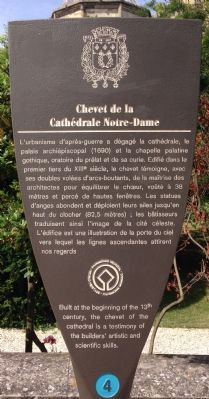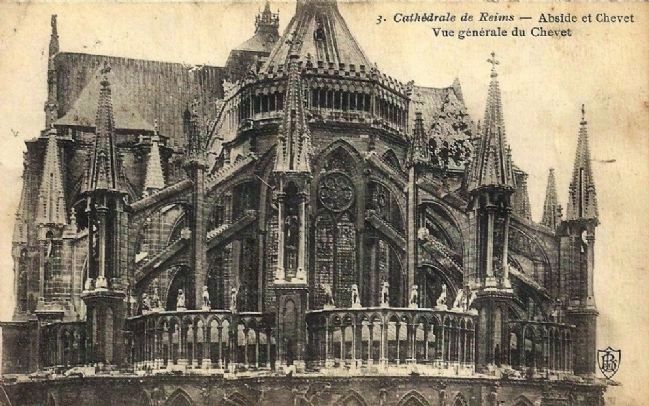Reims in Marne, Grand Est, France — Western Europe
Chevet de la Cathédral Notre-Dame
— World Heritage Site —
Built at the beginning of the 13th century, the chevet of the cathedral is a testimony of the builder's artistic and scientific skills.
English translation:
Postwar urban planning preserved the cathedral, the archbishop's palace (1690) and the Gothic palace chapel, the prelate oratory and his curia. Built in the first third of the thirteenth century, demonstrates how the masterly crafted chevet, with its double flights of flying buttresses, balances with the choir, vaulted to 38 meters and pierced with high windows. The statues of angels abound and spread their wings to the top of the bell tower (82.5 meters); reflecting the builders image of the heavenly city. The building is an illustration of the gate of heaven, with ascending lines to draw your attention upwards.
Erected by la ville de Reims. (Marker Number 4.)
Topics and series. This historical marker is listed in these topic lists: Arts, Letters, Music • Churches & Religion • Science & Medicine. In addition, it is included in the UNESCO World Heritage Sites series list.
Location. 49° 15.229′ N, 4° 2.133′ E. Marker is in Reims, Grand Est, in Marne. Marker is on Cours Anatole France, on the right when traveling south. Touch for map. Marker is at or near this postal address: 9 Cours Anatole France, Reims, Grand Est 51100, France. Touch for directions.
Other nearby markers. At least 8 other markers are within walking distance of this marker. Maison du Trésorier du Chapitre de la Cathédral (about 180 meters away, measured in a direct line); Palais du Tau (about 180 meters away); Cathédral Notre-Dame (about 180 meters away); Edmond Marin la Meslée (about 180 meters away); Porte et Place du Chapitre de la Cathédral (about 210 meters away); Louis XV (about 210 meters away); Place Royale (approx. 0.2 kilometers away); Médiathèque Jean Falala (approx. 0.2 kilometers away). Touch for a list and map of all markers in Reims.
Regarding Chevet de la Cathédral Notre-Dame. A chevet is, according to the Encyclopedia Britannica.com: "(the) eastern end of a church, especially of a Gothic church designed in the French manner. Beginning about the 12th century, Romanesque builders began to elaborate on the design of the area around the altar, adding a curved ambulatory behind it and constructing a series of apses or small chapels radiating from the ambulatory. Chevet design became most elaborate during the 13th century, and examples can be seen in the cathedrals of Rheims and Chartres…."
Credits. This page was last revised on September 10, 2018. It was originally submitted on July 18, 2015, by Kevin W. of Stafford, Virginia. This page has been viewed 515 times since then and 63 times this year. Photos: 1, 2, 3. submitted on July 18, 2015, by Kevin W. of Stafford, Virginia. 4, 5. submitted on July 20, 2015. • Andrew Ruppenstein was the editor who published this page.




